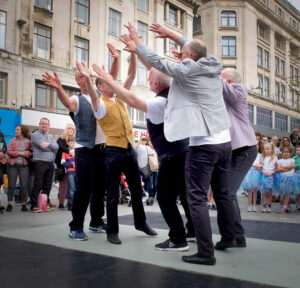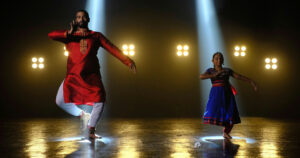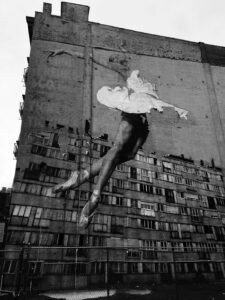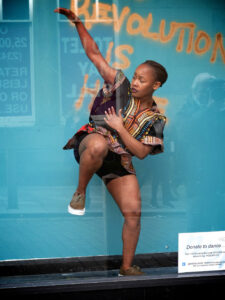
Today is 29th April and it marks a special day in the dance calendar as its International Dance Day

IDD 2016 Taciturn, photo: Dava Jonah
I first began to celebrate International Dance Day (IDD) in 1999, when as the Artistic Director of MDI (Merseyside Dance Initiative) a dance organisation based in Liverpool, I worked with the City Council and their Healthy City Campaign which was all about creating active ageing by 2000! We focussed on bringing communities together in the City Centre and in the latter years the project was led by Maxine Brown the organisations’ Community Dance Artist.
This day has a very special place in my heart and I wanted to share with you and explain what it’s all about.

IDD 2018 Men Dancing, photo: Dava Jonah
What is International Dance Day (IDD)?
IDD is a day where across the globe, people celebrate dance, be they organisations, institutions or individuals. It was originally created by the dance committee of the International Theatre Institute (ITI), who partnered with UNESCO. It takes place each year on 29th April which is the anniversary of Jean-Georges Noverre’s birthday, the person who created the modern ballet, born in 1727. The day encourages participation and the organisers always include a message from a prolific dance maker.
Why is it so important ?
The day strives to encourage participation and education in dance through events and festivals held on the date all over the world.
I know when I was at MDI, and before that really, I always had a belief that dance could make a difference to all people regardless of ability, gender, age or ethnicity. The whole top and bottom of it is, that dance is good for you, it improves your wellbeing, it’s a brilliant physical undertaking and it can be a powerful creative force in making a case for change and telling stories.
According to ITI “It’s a celebration day for those who can see the value and importance of the art form “dance”, and acts as a wake-up-call for governments, politicians and institutions which have not yet recognised its value to the people and to the individual and have not yet realised its potential for economic growth”.
Thus, ITI with the Dance Committee set out some particular goals for this event:
• To promote dance in all its forms across the world
• To raise awareness in people of the value of dance in all its forms
• To enable the dance community to promote their work on a broad scale, so that governments and opinion leaders are aware of the value and importance of dance in all its forms and support it.
• To enjoy dance in all its forms for its own sake.
• To share the joy of dance with others.

Credit: nik-radzi-tsVrM8Bq32I-unsplash.jpg
What is the Message?
An important part of the day is the message that is written by an outstanding choreographer or dancer and broadcast around the world. The author of the message is selected by the International Dance Committee of ITI and the Executive Council of ITI. The message is translated into numerous languages and circulated globally. https://www.international-dance-day.org/internationaldanceday.html (2020)
For 2020 the chosen artist is Gregory Vuyani Maqoma, from South Africa. Maqoma is a dancer, actor, choreographer and dance educator and is well respected for his collaborations with artists such as Akram Khan, Vincent Mantsoe, Faustin Linyekula, Dada Masilo, Shanell Winlock, Sidi Larbi Cherkaoui, Nhlanhla Mahlangu and Theatre Director James Ngcobo. In 2019 Maqoma collaborated with Idris Elba and Kwame Kwei-Armah in the production “Tree” produced by Manchester International Festival and the Young Vic.
Here is what he has to say:
“It was during an interview I had recently that I had to think deeply about dance, what does it mean to me? In my response, I had to look into my journey, and I realized that it was all about purpose and each day presents a new challenge that needs to be confronted, and it is through dance that I try to make sense of the world.
We are living through unimaginable tragedies, in a time that I could best describe as the post- human era. More than ever, we need to dance with purpose, to remind the world that humanity still exists. Purpose and empathy need to prevail over years and years of undeniable virtual landscape of dissolution that has given rise to a catharsis of universal grief conquering the sadness, the hard reality that continues to permeate the living confronted by death, rejection and poverty. Our dance must more than ever give a strong signal to the world leaders and those entrusted with safeguarding and improving human conditions that we are an army of furious thinkers, and our purpose is one that strives to change the world one step at a time. Dance is freedom, and through our found freedom, we must free others from the entrapments they face in different corners of the world. Dance is not political but becomes political because it carries in its fibre a human connection and therefore responds to circumstances in its attempt to restore human dignity.
As we dance with our bodies, tumbling in space and tangling together, we become a force of movement weaving hearts, touching souls and providing healing that is so desperately needed. And purpose becomes a single hydra-headed, invincible and indivisible dance. All we need now is to dance some more!!!! “
More information about Maqoma can be found here: https://vuyani.co.za/about-us/
How do people take part and get involved?
Anybody can take part its open and accessible to all, however ITI recommends that individuals or institutions who want to celebrate the day to coordinate it with the ITI Centre or Cooperating Member in their country or region.

Photo by Jon Tyson on Unsplash
What types of dance can be seen?
All dance forms are represented from all over the globe covering lots of styles – anything goes and over the years I have witnessed so many dances: Jazz, Street, ballet, traditional African, Caribbean, Chinese and South Asian; alongside Contemporary, Breakdancing, Tango and Vogue, and many more. Performances have taken place in theatres but mostly outdoors, shopping malls and shop windows. Showcasing performers from the communities from aged 5 – 85 year old alongside dance students and professional artists was absolutely key and I believe totally represents the goals of the day, bringing people together and creating social impact.
There are so many ways to celebrate be that live or online, however at the time of writing most countries are in lockdown, as governments enforce a social isolation strategy in order to combat the Covid-19 virus. Thus everyone celebrating this year will do so virtually, so please check wherever you live and find a way to take part maybe through writing a blog like this, reading the message to others, recording it or distribution through online platforms such as:
• Facebook
• Instagram
• Twitter
• Youtube channel
• Tik Tok

IDD 2016 Charlene Kaliyati Photo: Dava Jonah
Links
To see what is happening locally today for IDD 2020 Check my platforms:
KGA:
Twitter: @kg_associates
Facebook: @KarenGandAssociates|
Instagram: kg_associates
And those of the Arts Centre at Edge Hill University who will create an online dance festival from 11 am
Arts Centre
Twitter: @ArtscentreEHU and @EHUPerfArts
Facebook: /theartscentreEHU
Instagram: artscentreEHU
Use this day as a real chance to dance and in the words of the late Bruce Forsyth….. “Keeeeep Dancing!”
#dance #internationaldanceday2020
